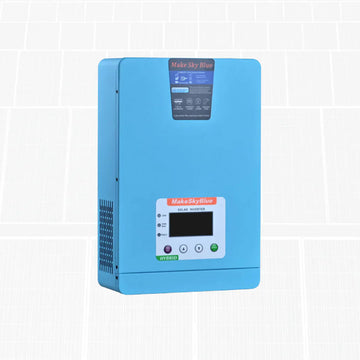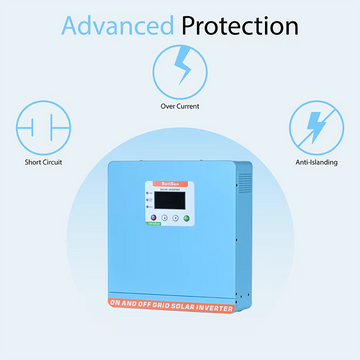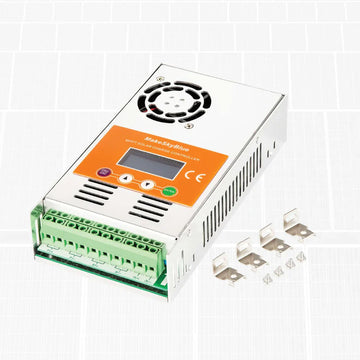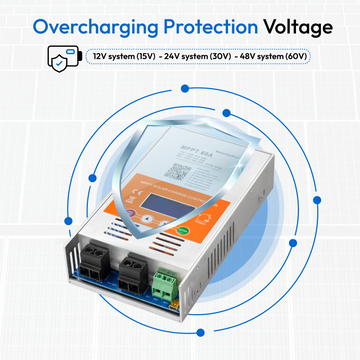Understanding how a solar panel and charge controller operate together protects batteries and maximizes solar energy harvest. These devices regulate voltage from panels before reaching batteries, preventing damage from overcharging or deep discharge.
The global solar charge controller market reached $2.59 billion in 2024 and projects growth to $7.14 billion by 2030. This expansion reflects increasing solar adoption worldwide. Battery protection remains the primary reason homeowners and businesses invest in quality charge controllers. Without proper regulation, expensive battery banks fail within months instead of lasting years.
What Makes Solar Panel and Charge Controller Systems Critical
Panels produce 16 to 20 volts from standard 12-volt modules. Batteries only need 14 to 14.5 volts for complete charging. This voltage gap creates problems without regulation.
Unregulated charging causes battery voltage to rise excessively, resulting in internal heat, electrolyte loss, and grid corrosion. Controllers prevent these issues by adjusting power flow dynamically. They also block reverse current at night when panels would drain batteries.
Modern systems demand reliable protection as solar installations expand globally.
How Solar Panel and Charge Controller Technology Works
Controllers monitor battery voltage continuously and adjust charging accordingly. Three distinct stages manage the charging process effectively.
Bulk charging delivers maximum current until batteries reach preset voltage levels. Absorption stage maintains constant voltage while current decreases gradually. Float stage provides minimal power to keep batteries fully charged without damage.
This intelligent regulation extends battery lifespan significantly. Temperature compensation features adjust voltage based on ambient conditions. Quality controllers include safety protections against short circuits and reverse polarity.
PWM and MPPT Solar Panel and Charge Controller Types
PWM controllers held 45.7% market share in 2024, while MPPT technology expects the highest growth rate through 2030. Each technology suits different applications based on system size and budget.
PWM controllers directly connect panels to batteries, pulling panel voltage down to battery level. They cost less but waste some panel capacity. MPPT controllers track maximum power points and convert excess voltage into additional current. This results in 20-30% more power harvest compared to PWM systems. Larger installations benefit most from MPPT efficiency despite higher initial costs.
Sizing Your Solar Panel and Charge Controller Correctly
Calculate total panel wattage and divide by battery voltage to determine required amperage. Add 25% margin for temperature variations and future expansion.
Example: 400 watts of panels with 12-volt batteries needs 33 amps (400÷12). Adding safety margin requires a 40-45 amp controller. Undersized controllers overheat and fail prematurely. Oversized units provide room for system growth without replacement costs.
Voltage ratings include 12V, 24V, 36V, 48V, and 96V options. Match controller voltage to battery bank specifications.
Key Features in Modern Solar Panel and Charge Controller Units
Advanced controllers offer capabilities beyond basic regulation. Temperature compensation adjusts charging based on battery temperature readings.
Low voltage disconnect protects batteries from excessive discharge damage. Digital displays show real-time system performance including voltage, current, and charging status. WiFi connectivity enables smartphone monitoring from anywhere. In March 2024, SMA Solar Technology announced IoT-integrated systems with app-based monitoring for maximizing energy output.
Multi-battery chemistry support accommodates lead-acid, lithium, and other types. BMS activation features wake lithium batteries from protection mode automatically.
Installing Solar Panel and Charge Controller Systems Safely
Proper connection sequence prevents equipment damage. Connect battery to controller first using correct wire gauge. Verify polarity before proceeding to next steps.
Next, attach solar panels to controller input terminals. Finally, connect any DC loads to designated terminals. This order ensures controller circuits receive power before panel input arrives. Always disconnect in reverse order during maintenance.
Include fuses at battery and panel connections for overcurrent protection. Use wire sizing charts based on amperage and cable length. Poor connections cause voltage drops and reduce system efficiency.
Recent 2025 Solar Panel and Charge Controller Market Developments
In January 2025, Bluetti launched EnergyPro 6K and Apex 300 with 3840W output and expandable 58kWh storage for off-grid applications. These integrated solutions simplify installations significantly.
Asia Pacific dominates with 56% global market share driven by rapid industrialization and rural electrification programs. China and India lead regional growth through aggressive renewable energy targets.
Smart controllers with AI optimization now learn usage patterns and weather forecasts. These systems automatically adjust charging strategies for maximum efficiency.
Battery Chemistry Impact on Solar Panel and Charge Controller Selection
Different batteries demand specific charging profiles. Lead-acid types include flooded, AGM, and gel variants. Each requires distinct voltage settings for optimal performance.
Flooded batteries tolerate higher voltages during charging. Sealed AGM batteries need precise regulation to prevent damage. Lithium batteries offer superior performance but require compatible controllers with proper voltage limits.
LifePO4 batteries need 14.2-14.6 volts for 12V systems. Controllers must prevent overcharge regardless of seasonal temperature changes and load variations. Temperature compensation becomes critical across all chemistries.
Common Solar Panel and Charge Controller Problems
Overheating indicates undersized controllers or poor ventilation. Ensure adequate airflow around mounted units. Extreme temperatures affect charging efficiency significantly.
Battery not charging suggests reversed polarity, blown fuses, or failed components. Check connections systematically before replacing parts. Reduced solar output often results from dirty panels or shading issues rather than controller problems.
Low voltage warnings may indicate undersized battery banks for connected loads. Monitor daily discharge cycles and adjust system capacity accordingly. According to the U.S. Department of Energy, storage systems paired with solar allow power supply regardless of weather conditions.
Off-Grid Solar Panel and Charge Controller Applications
Remote locations depend entirely on reliable charge regulation. In November 2024, Light secured $176 million for off-grid African projects emphasizing charge controller importance for battery protection.
Off-grid systems require careful sizing since no utility backup exists. Controllers prevent battery damage that would leave systems without power. Rural electrification programs worldwide deploy millions of controllers annually.
RV and marine applications demand compact controllers with harsh environment protection. Portable systems for camping need lightweight options with essential features only.
Maintaining Solar Panel and Charge Controller Performance
Monthly inspections catch problems early. Check all wire connections for corrosion or looseness. Verify display readings match expected values during charging hours.
Clean panel surfaces regularly to maintain maximum output. Dust and debris reduce power generation significantly. Record voltage measurements monthly to track battery health trends.
Update controller firmware when manufacturers release improvements. Modern units receive software updates through WiFi connections. Replace controllers showing consistent errors or overheating issues promptly.
Latest 2024-2025 Solar Panel and Charge Controller Innovations
The market grew from $2,565 million in 2024 and projects reaching $7,901 million by 2032 with 15.1% annual growth. Technology advances drive this expansion rapidly.
Cloud-based monitoring platforms aggregate data from multiple sites. Managers track entire solar portfolios through single dashboards. Predictive maintenance algorithms identify failing components before system outages occur.
Multi-string MPPT controllers allow mixing different panel types or orientations. This flexibility suits complex roof layouts and partial shading situations. Integrated inverter-charger combinations reduce component counts and installation complexity.
Conclusion
Proper solar panel and charge controller integration protects batteries while maximizing energy harvest. MPPT technology offers superior efficiency for most applications despite higher costs. Understanding charging stages, voltage requirements, and battery chemistry ensures optimal system performance. Regular maintenance and monitoring extend equipment lifespan significantly. Quality controllers from specialized manufacturers provide advanced features and reliable operation. As solar adoption accelerates globally, charge controllers remain essential components for successful installations. For professional MPPT controllers with WiFi monitoring and multi-battery support, explore solutions at MakeSkyBlue offering reliable solar system components.
FAQs
Can solar panels work without charge controllers?
Small panels under 5 watts with trickle charging applications sometimes operate without controllers. However, most systems require regulation to prevent battery damage. Charge controllers prevent batteries from overcharging when reaching full capacity.
What happens if charge controller fails?
Battery overcharging occurs immediately causing permanent capacity loss. Excessive voltage creates heat and electrolyte loss. Replace failed controllers quickly to avoid expensive battery replacement costs.
Do MPPT controllers justify higher costs?
Systems over 200 watts benefit significantly from 20-30% efficiency gains. MPPT controllers pay for themselves through increased power harvest. Small systems under 100 watts work adequately with PWM technology.
How long do quality charge controllers last?
Premium units operate reliably for 10-15 years with proper installation. Electronic components degrade gradually over time. Controllers typically outlast battery banks in well-designed solar systems.
What size controller for 400-watt solar panels?
Divide 400 watts by battery voltage then add 25% safety margin. For 12V systems, this calculates to 42 amps minimum. Choose 45-60 amp controllers for adequate capacity and future expansion.




